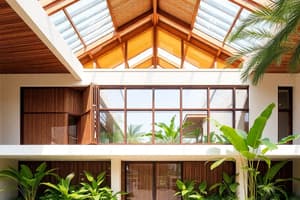Podcast
Questions and Answers
What does comfort refer to in the context of architectural design?
What does comfort refer to in the context of architectural design?
Creating spaces that are physically, emotionally, and environmentally conducive to human well-being.
Which of the following factors significantly affect thermal comfort?
Which of the following factors significantly affect thermal comfort?
- Temperature
- Humidity
- Airflow
- All of the above (correct)
What is the Predicted Mean Vote (PMV)?
What is the Predicted Mean Vote (PMV)?
An index that predicts thermal comfort based on factors such as air temperature, humidity, airspeed, and clothing insulation.
A PPD below ______% is generally considered acceptable for comfort.
A PPD below ______% is generally considered acceptable for comfort.
Visual comfort is primarily about preventing noise in a building.
Visual comfort is primarily about preventing noise in a building.
What is the ideal Daylight Factor (DF) range for tropical environments?
What is the ideal Daylight Factor (DF) range for tropical environments?
What is the Noise Reduction Coefficient (NRC)?
What is the Noise Reduction Coefficient (NRC)?
What design solution can improve thermal comfort?
What design solution can improve thermal comfort?
The ______ is a rating used to control glare from artificial lighting.
The ______ is a rating used to control glare from artificial lighting.
Which of the following materials is effective for acoustic comfort?
Which of the following materials is effective for acoustic comfort?
Flashcards are hidden until you start studying
Study Notes
Comfort in Tropical Architecture
- In architecture, comfort encompasses physical, emotional, and environmental factors that contribute to human well-being.
- Tropical design prioritizes comfort by addressing the challenges of hot and humid climates.
- Tropical architecture aims to create spaces that provide relief from external conditions, such as excessive heat and humidity.
Thermal Comfort
- Thermal comfort refers to the perception of temperature in a building.
- In tropical regions, managing indoor temperatures is crucial due to hot and humid conditions.
- Design solutions to achieve thermal comfort:
- Natural Ventilation: Maximizing airflow through cross-ventilation.
- Shading Devices: Utilizing roof overhangs, louvers, and shading screens to block direct sunlight.
- Materials: Opting for lightweight materials like wood and bamboo.
Factors Affecting Thermal Comfort
- Temperature: Maintaining a cool interior temperature is essential.
- Humidity: Reducing indoor moisture is crucial to mitigate the discomfort caused by high humidity.
- Airflow: Ensuring proper airflow (cross-ventilation) helps cool down the space naturally.
Thermal Comfort Indices and Measurement Methods
- Predicted Mean Vote (PMV): A widely used index predicting thermal comfort based on factors such as air temperature, humidity, airspeed, and clothing insulation.
- PMV values range from -3 (cold) to +3 (hot), with 0 indicating thermal neutrality.
- Predicted Percentage Dissatisfied (PPD): This index measures the percentage of people likely to be dissatisfied with the thermal environment.
- A PPD below 10% is generally considered acceptable for comfort.
- Thermal Sensation Vote (TSV): This method gathers direct feedback from building occupants, where they rate their thermal comfort on a scale similar to PMV.
Visual Comfort
- Visual comfort involves providing adequate natural light without causing glare or excessive brightness.
- In tropical climates, abundant sunlight poses a challenge in balancing daylight and visual comfort.
Visual Comfort Design Solutions
- Windows and Skylights: Strategic placement for balanced lighting.
- Shading Screens: Utilizing wooden screens or external louvers to prevent harsh direct sunlight.
- Light Diffusion: Implementing methods to disperse direct sunlight, preventing glare.
Visual Comfort Indices and Measurement Methods
- Daylight Factor (DF): This metric expresses the percentage of available daylight inside a room compared to the unobstructed daylight outside under overcast sky conditions.
- A DF between 2% and 5% is ideal for tropical environments, balancing sufficient daylight and preventing overheating.
- Unified Glare Rating (UGR): An objective measure of glare used in lighting design to control the risk of occupant glare from artificial lighting.
- A UGR value below 19 is generally considered comfortable.
Acoustic Comfort
- Acoustic comfort relates to noise control within a building.
- In tropical environments, heavy rain, urban sounds, and wildlife can disrupt acoustic comfort.
- Effective sound control is crucial in both residential and commercial spaces.
Acoustic Comfort Design Solutions
- Sound-Absorbing Materials: Utilizing materials like acoustic panels, carpets, and curtains to absorb sound.
- Noise Barriers: Implementing trees, walls, or soundproof windows to block external noise.
Acoustic Comfort Indices and Measurement Methods
- Noise Reduction Coefficient (NRC): A single number value (0.0 to 1.0) representing the average sound absorption performance of a material.
- An NRC of 0.0 indicates no sound attenuation; materials with an NRC of 0.6 or higher are effective for sound absorption.
- Sound Transmission Class (STC): This rating assesses the sound isolation of a building wall assembly.
- A higher STC rating indicates better sound isolation.
- STC is frequently used to assess interior partitions, ceilings/floors, doors, and windows.
Studying That Suits You
Use AI to generate personalized quizzes and flashcards to suit your learning preferences.




